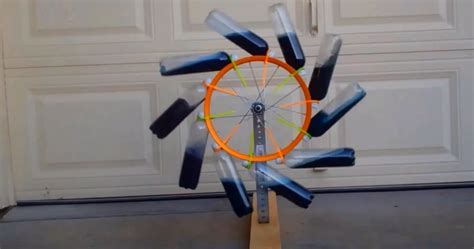Gravity wheels come in many forms.
https://www.lockhaven.edu/~dsimanek/museum/overbal.htm
The Shifting-Mass Overbalanced Wheel
Why it isn't perpetual motion.
From the 8th century to the present time inventors have sought to achieve perpetual motion by use of wheels with shifting weights. None have worked, but that doesn't stop people from using the same idea again and again,
altering mechanical details, often with incredibly complex designs. I call this "reinventing the square wheel".

Quite a number of books tell of this futile quest, citing examples with nice pictures of the failed designs. Few of these books give a simple conceptual explanation of why they don't work and why they can't work. Nor do these books expose the flaws of thinking that led people to believe they might work.

Since our theme is puzzles, consider the pretty design shown here. The idea for this as a perpetual motion puzzle was sent to me by Slawek Liszewski. It is a wheel with three equal compartments, constructed using arcs of circles. Put equal amounts of liquid (red) half-filling each compartment. (1) In what position(s) will the wheel be in static equilibrium? Or will the wheel be in static equilibrium in every position? (2) Will these answers be the same for any chosen amount of liquid (but with the same amount in each compartment)? Show and justify all mathematical steps in your solution.






https://www.lockhaven.edu/~dsimanek/museum/overbal.htm
The Shifting-Mass Overbalanced Wheel
Why it isn't perpetual motion.
From the 8th century to the present time inventors have sought to achieve perpetual motion by use of wheels with shifting weights. None have worked, but that doesn't stop people from using the same idea again and again,
altering mechanical details, often with incredibly complex designs. I call this "reinventing the square wheel".

Quite a number of books tell of this futile quest, citing examples with nice pictures of the failed designs. Few of these books give a simple conceptual explanation of why they don't work and why they can't work. Nor do these books expose the flaws of thinking that led people to believe they might work.

Since our theme is puzzles, consider the pretty design shown here. The idea for this as a perpetual motion puzzle was sent to me by Slawek Liszewski. It is a wheel with three equal compartments, constructed using arcs of circles. Put equal amounts of liquid (red) half-filling each compartment. (1) In what position(s) will the wheel be in static equilibrium? Or will the wheel be in static equilibrium in every position? (2) Will these answers be the same for any chosen amount of liquid (but with the same amount in each compartment)? Show and justify all mathematical steps in your solution.


Comment